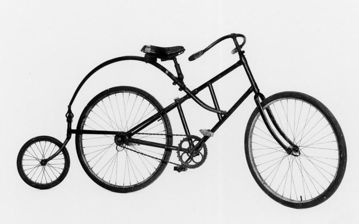 When I read that the Smithsonian Institution will digitize its collection of 137 million artifacts, I headed over there to see what the national museum currently has posted online in terms of bicycles.
When I read that the Smithsonian Institution will digitize its collection of 137 million artifacts, I headed over there to see what the national museum currently has posted online in terms of bicycles.
The museum has photos of 45 bicycles online in its America on the Move Bicycle Collection and a couple of dozen other images of helmets, anti-car buttons and turn-of-the-century pro-bicycling pamplets.
The images in the collection run from a two-wheeled hobby horse manufactured in 1818 to a Schwinn Super Deluxe Sting-Ray made in 1965. There are standard bicycles, ordinary bicycles, bone shakers, and tandems. You'll recognize the names Schwinn, Columbia, Raleigh, and Pierce, among others.
In addition to identifying the bikes, the curators describe the bicycles and tell how they showed up in the collection.
Raleigh
The 1949 Raleigh bicycle pictured above, for instance, was ridden from Bogata, Colombia, to Washington DC in 1950 by Alvaro Zabala. The 8,000-mile trip took about five months, at the end of which he donated it to the Smithsonian. It's pictured with the flags of the 10 countries he traversed.
The bike weighs 33 pounds. Here's a description of the gearing. Imagine dealing with this set up on a bike tour:
“Attached to the rear wheel is a 3-gear, compound sprocket, made by Cyclo, of Birmingham, England, that contains 16, 20, and 24 teeth, respectively, in its three gear sections. These turn as a unit with respect to the wheel, and contain an overrunning clutch between the hub of the unit and the hub of the wheel so as to permit coasting.
“In use, the chain is engaged with one of the three gear sections, depending on the terrain to be covered. Changing is accomplished by loosening the wing nuts of the rear axle, placing the chain over the gear section desired, adjusting the chain tension by moving the wheel and axle within slots provided at the rear of the frame, and tightening the wing nuts. Another 16-tooth gear is rigidly attached to the other side of the wheel. By removing the wheel and turning it around in the frame, this gear, which allows no coasting, can be used.”
The bike has a Brooks saddle and the Swiss-made Lucifer Aero B-1 headlamp is powered by a generator.
There are descriptions like that for many of the bikes in the collection.
The photos and write-ups were published in the 1974 book “Wheels and Wheeling: the Smithsonian Cycle Collection.” The web version of the book doesn't include bicycles that were acquired after the book was published in 1974. The America on the Move Bicycle Collection does include a good article on the development of the bicycle.
Rex Bicycle
 This Rex Bicycle made in Chicago is one of the more unusual bicycle designs. Even though it has three wheels, the Smithsonian classifies it as a bicycle because the third-wheel isn't used for stability.
This Rex Bicycle made in Chicago is one of the more unusual bicycle designs. Even though it has three wheels, the Smithsonian classifies it as a bicycle because the third-wheel isn't used for stability.
Designed by Bohn C. Hicks of Chicago, the third wheel is “particularly adapted to absorb or minimize the shocks incident to riding over obstructions.” It was built in 1896. According to the description:
“This objective, stated in the patents, was accomplished by mounting the seat near the front of a long tube, extending from a pivot near the front wheel to the smaller rear wheel. Consequently, the successive upward movements of the front and driving wheels, as they passed over a bump, caused minimal upward movement of the pivot point and, hence, of the seat. Likewise, by reason of the distance from the small rear wheel to the seat being greater than that from the seat to the pivot, the subsequent upward movement of that wheel was also minimized. The cycle, in effect, undulated over bumps, leaving the level of the seat relatively unaffected.”

Recent Comments